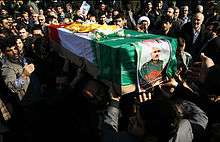Hassan Shateri
| Sardar Hassan Shateri | |
|---|---|
|
| |
| Native name | حسن شاطری |
| Nickname(s) | Hessam Khoshnevis |
| Born |
1955 Semnan |
| Died |
February 12, 2013 (aged 57–58) Syria |
| Allegiance |
|
| Rank | General[1] |
| Unit | Quds Force |
| Battles/wars | 1980 Sardasht Conflict, Iran–Iraq War |
Hassan Shateri (Persian: حسن شاطری; 1955 – February 12, 2013), also known as Hesam Khoshnevis,[2] was a senior commander of Iran's elite Revolutionary Guards.[3] He was a veteran of the Iran–Iraq war[3] and head of the Iranian Committee for the Reconstruction of Lebanon after the 2006 Lebanon War, according to Iranian media.[4] He was assassinated in February 2013.[5]
Hojatoleslam Panahian said that "Our Shateri was no less than Mughniya", in his meeting with Shateri some years ago in Lebanon’s embassy.[2]
Life
Shateri was born in Semnan, Iran, in 1955[6] to a religious family. In his teens, he actively participated in demonstrations against the Shah. He studied civil engineering.[6] Following the Islamic revolution in Iran, he joined Basij in 1979.[6] In 1980, when anti-revolution forces had captured Sardasht, he went there to participate in the fighting against them.[7]
He was a battalion commander in 1981; head of logistics and operations of Hamza Sayyed al-Shohada Camp in 1983; head of logistics and operations, and chief of staff, of the Sardasht deployed army in 1984; commander of operations of Sardasht in 1985–87; head of the engineering unit in Hamza Sayyed al-Shohada Camp in 1988; engineering unit deputy commander of the Hamza Sayyed al-Shohada Camp in 1990; and commander of the Isfahan sepah engineering unit.[7]
Assassination

He was assassinated in Syria on February 12, 2013.[5] According to a report by The Sunday Times, he was killed in an alleged IAF airstrike which had as its target a convoy carrying weapons between Syria and Lebanon.[8] Other reports said he was killed inside Syria by rebel militants battling the Syrian government.[4] Iranian news outlets blamed his death on "Zionist agents".[5] IRGC spokesman Ramezan Sharif claimed that Shateri had been murdered by Israeli agents.[9] He had been in Aleppo before being killed.[2]
The attack was perpetrated close to the Lebanese border near the city of Zabadani, according to a Syrian opposition commander.[4] Rami Abdel Rahman, the director of the Syrian Observatory for Human Rights, told AFP: "We do not know exactly where he was shot, but we do know that a rebel group ambushed his vehicle while en route from Damascus to Beirut".[1]
He had been an assassination target for some time; men suspected of planning such an attack had been arrested, according to sources inside Hezbollah.[1]
Funeral
He was buried in Tehran.[10] IRGC commander Mohammad Ali Jafari, Qods Force Commander Qasem Soleimani, and other Iranian officials attended his funeral.[9]
References
- 1 2 3 Sherlock, Ruth (14 February 2013). "Iran commander assassinated in Syria". Telegraph.co.uk. Retrieved 10 April 2016.
- 1 2 3 Javedanfar, Meir. "Assassination Will Not Weaken Iran's Support for Assad –". Al-Monitor. Retrieved 3 April 2016.
- 1 2 Dehghan, Saeed Kamali (14 February 2013). "Elite Iranian general assassinated near Syria-Lebanon border". The Guardian. Retrieved 3 April 2016.
- 1 2 3 Dominic, Evans; Karouny, Mariam (15 February 2013). "Iranian Guards commander killed in Syria". Reuters. Retrieved 3 April 2016.
- 1 2 3 Fassihi, Farnaz. "Iranian General Is Killed in Syria". Wall Street Journal. Retrieved 3 April 2016.
- 1 2 3 Will Fulton (28 February 2013). "The Assassination of Iranian Quds Force General Hassan Shateri in Syria". Iran Tracker. Retrieved 16 May 2016.
- 1 2 Staff writers. "Who was engineer Hassan Shateri?". Raja News. Retrieved 1 May 2016.
- ↑ Fisher, Gabe (24 February 2013). "'Israel's strike on Syria last month killed top Iranian general'". The Times of Israel. Retrieved 1 May 2016.
- 1 2 Levy, Elior (14 February 2013). "Rebels: Iranian official killed in airstrike on Syria". ynet. Retrieved 10 April 2016.
- ↑ "Funeral for Iranian senior Revolutionary Guard leader". BBC. 14 February 2013. Retrieved 16 May 2016.
External links
 Media related to Hassan Shateri at Wikimedia Commons
Media related to Hassan Shateri at Wikimedia Commons